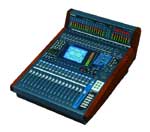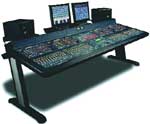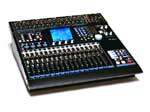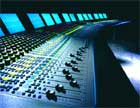The SeriesTwelve, says Dooley, might be considered the Swiss Army Knife of mixing consoles. It can be used for film and traditional post, as well as for music recording and live on-air broadcasting. The SeriesTwelve offers an array of panel interfaces and can be outfitted in any number of configurations.
The ST2 is designed for feature film and other post applications requiring a large-scale digital console. It's offered with a wide variety of control surface options and features Harrison's PCI-based IKIS Automation, along with touch-sensitive control knobs and a two-toned color scheme.

Yamaha's DM1000 is an affordable, 96 kHz surround-capable board designed specifically for post work.
|
The MPC console, notes Dooley, is really designed for feature film use. There is a limit on panel options, and both input panels and faders configurations are standard. Film mixers will appreciate the MPC's familiar pec/direct panel for interfacing with dubbers.
Harrison has been focusing its efforts on bringing its latest automation platform online. The new IKIS automation platform runs on the PC/Intel platform, stepping away from the Mac platform it's used for years. IKIS provides 10 EQ shapes, 30 dB gain/cut, expanded dynamics controls and increased control resolution.
What differentiates the PC platform from the Mac automation is its scalability. "There is no real limit as to the size that the console can scale out to," says Dooley. "It's dramatically more visual in terms of its interface."
Boards already using the Mac version with the company's digital back-end can switch over to the PC version without any problems, helping to future-proof the system.

Fairlight's (www.fairlightesp.com) DREAM is a standalone digital audio system that combines a 192-channel mixer with a fully-integrated 48-track disk recorder/editor. The system can operate at a variety of sample rates, up to 96 kHz. The console is available in various chassis sizes each of which can be configured with a choice of fader numbers, central assignment panels and meter bridges.
|
The MPC3-D is an evolution of the company's MPC and brings forward its traditional controls and familiar panel layout. Controls have been enhanced and now include dedicated eight-band EQ controls per strip, dedicated dynamics controls per strip and expanded panning controls. The console can accommodate any combination of input sections and custom master section layouts. By design, the MPC3-D is a large-scale, multi-operator console and can be configured as a one-, two- or three-operator desk. Software plug-ins allow the user to choose features and functions according to their need.
Sony Pictures was one of the first to switch to the digital back end. The facility has 10 Harrison consoles, five of which are digital.

Sony's R100 benefits from developments for its high-end OXF-R3 console, as well as from efficiencies made possible through its manufacturing plant.
|
SONY
Sony has seen a lot of success with itsDMX-R100 digital mixer (www.dmx-r100.com). The company had sold 1,800 of them as of AES '02, and product manager Karl Kussmaul says it's possible that the number has reached 2,000 by now. Kussmaul attributes the R100's success to the efficiency in production that Sony offers through its manufacturing plants in Japan, combined with the feature set developments that come from its high-end OXF-R3 console.
Sony recently announced an upgrade to the R100 at the winter NAMM show in Anaheim. The console now features V. 2.21 software giving it MADI support that Kussmaul says is usually reserved only for higher-end, expensive consoles.
"We elected to go with MADI because it is truly a professional multichannel audio standard." A new system interface - the SIU 100 - will be available in April and expands on the number of I/O and its interconnecting capabilities.
Kussmaul notes that while many facilities would like to see savings by investing in smaller format boards, it was only recently that these lower-cost offerings could provide the necessary feature sets for handling professional demands.
"People would try to integrate lower-cost technology when they could. But the products weren't really up to the job. Now that is turning around quite a bit."
EUPHONIX
Andrew Wild, VP of marketing communications for Euphonix (www.euphonix.com), says the company had a good second half in 2002. There are almost 125 of Euphonix's System 5 consoles in the market today, and the company is continuing to develop the 24-bit, 96 kHz board, having released the V. 2.6 upgrade back in September at AES. The latest upgrade includes improvements to the System 5's EQs, notch filters, mix automation, control surface and display graphics.
"In the post world, there is an acceptance of the digital console as the way to go," says Wild. "It took about four of five months for [the economy] to really get on its feet. But the end of the year was good for us. We sold a lot of consoles."
Euphonix is very optimistic for this coming year. System 5 user Technicolor recently upgraded its room to handle television work such as Steven Spielberg's Taken series (See Post's Web site for the complete story) and Wild thinks that might be a trend. "Other [studios] are going to want to match them to be competitive. They are going to need hundreds of inputs and absolute control over their digital systems, and that's a strong points of the System 5."
Expect product news from Euphonix later this year, as part of a "short-form post plan" that ties into its work with DAW software manufacturer Steinberg (now owned by Pinnacle). Back at AES the two companies announced a strategic relationship to develop integrated professional audio products.
"The CS console was great for [short-form work]," says Wild. "It was lower cost and compact, but very powerful. The System 5 is out of that cost range."
The new release is expected to share resources between the DAW and mixing console. "You might be using some on-board effects on the DAW and you might be using some stuff on the console," he explains. "It won't necessarily be a keyboard and mouse replacement. It will actually be as much or as little I/O and processing as you want."

TASCAM recently introduced V.2.03 for its DM-24, giving it 20 new features and functions.
|
TASCAM
At the recent NAMM show in Anaheim, TASCAM demonstrated the V.2.03 operating system update for its DM-24 digital mixer. The update is available as a free download from the company's Web site (www.tascam. com) and adds 20 new features and functions to the console. Updates include HUI emulation, new footswitch control capabilities, improved internal signal routing and direct surround panning capabilities.
The HUI emulation mode allows the DM-24 to be used as a control surface for music/audio software like Pro Tools, Digital Performer and Nuendo. Faders, pans and mutes, as well as aux sends, track arming and transport controls can all be controlled in these DAW applications via the DM-24.

Euphonix has nearly 125 System 5s in the field today and will have a new product later this year.
|
V.2.03 also includes new 5.1 surround mixing features. A low-pass filter on the LFE channel allows users the ability to send select frequencies below the LPF point to a stem recorder. The new Center Channel Percentage parameter regulates how much of the channel's signal is sent to the center channel of the stem recorder. V.2.03 also includes a new utility page offering 13 functions that the external footswitch can perform.
The TASCAM DM-24 is priced at $2,999 and features 24-bit digital converters, up to 96 kHz sampling rates and 32-bit internal processing.
STUDER
Studer (www.studer.ch) addressed the post/film market in 2002 with the introduction of its Vistonics control surface technology at NAB. Vistonics was first used on Studer's Vista 7 broadcast production and post production console.
Vista 7 can have from 20 to 70 physical channels in groups of 10, plus a central control bay, and each bay of 10 channels is built around the Vistonics graphic control surface. Vistonics integrates rotary controls within a full-color flat-screen display, giving immediate access to all available controls. The interest in this concept at NAB, IBC and AES resulted in one of the fastest placement of orders in Studer's 50-year product history.
Studer recognizes the importance of automation and machine control in post applications. The Vista 7's AutoTouch Plus system offers dedicated buttons for multi-machine control, track arming, and more, with the option of fully-integrated control of all machines via Soundmaster's touch-screen technology.
Studer is also continuing the production of its D950 M2, with nearly 200 units in the field worldwide. The system is Studer's largest digital console and offers custom options and sizes that are not available with the Vistonics control surface.
DIGIDESIGN
Scott Wood, senior product manager/ post production at Digidesign (www. digidesign.com) says that pairing a Pro Tools workstation with the company's ProControl surface is a very attractive solution for pros looking to open or upgrade a post room. Users can get a turnkey recording and mixing solution, says Wood, for well under $100,000. That's less than some higher-end consoles alone.
While ProControl is an interface to Digidesign's Pro Tools DAW, Wood says it's not much different than AMS Neve, Harrison and Euphonix consoles, all of which are control surfaces that interface with a digital engine in a machine room.
"The major difference is the [Digidesign system] that sits in the rack can not only handle the automation and mixing, but the audio and effects processing," explains Wood.
Wood also touts the future-proof design of ProControl. "The cool thing about the ProControl is that, originally, it was released when Pro Tools|24 was available. That was updated to Pro Tools Mix, and now to HD, so those people that made the investment back in the 16-bit, 48 kHz days can use their same console control surface at 128 tracks and 192 kHz."
ProControl supports 48 faders. A base unit starts at $13K, and each eight-channel expansion is $6,500.
"Generally, a lot of people go with a 24- or 32-fader system, so the console control surface costs around $30 to 35K," notes Wood.
When asked about how Digidesign's affordable tools are impacting the way studios bill their clients, Wood says, "It's allowing a natural market progression. Video people understand the NLE process and they want it with audio, too. They expect the same market developments to happen in audio that they've seen happen in video."
SOUNDTRACS
James Gordon, sales director for Soundtracs (www.soundtracs.com) in the UK, describes 2002 as a "transitional" and "peaky" year. Gordon says, normally, the company sees slow but steady sales throughout the year, but in 2002, it saw a number of sales right out of the gate, particularly in New York and Boston, before things slowed a bit.
Soundtracs offers a broad line of 24-bit, high-end post-oriented consoles, starting with its DS3. The console is available in 24- or 32-fader configurations and is ideal, says Gordon, for commercial TV and smaller film projects.
The company's DPC-II is in the middle of the Soundtracs line and has seen a lot of success, especially in New York, with facilities doing TV work. And at the higher end is the D4 with more bussing than the other two. Gordon says the D4 can be used for TV work, as well as for high-end music and film work.
The differences between the Soundtracs releases are mainly the number of busses and the physical layout of their design.
Soundtracs offers its own networking solution in Net-Tracs, which consists of a central server that allows each Soundtracs console within a facility to backup to the server or swap projects from one room to another. It also offers an on-board effects package that can be added to any of its consoles. The package includes approximately 40 different effects, six of which can run simultaneous.
MACKIE
Mackie (www.mackie.com) offers a number of control surfaces designed to accompany DAWs. At the recent NAMM show in Anaheim, the company announced that its Mackie Control will now interface with Digidesign's Pro Tools.
Mackie Control is a nine-fader MIDI controller that provides mixing, editing and automation control for any supported digital audio workstation. The system already supports Cakewalk Sonar, Magix Samplitude, MOTU Digital Performer and Steinberg's Cubase and Nuendo products, as well as Mackie's own Soundscape 32.
The company added HUI Mode to Mackie Control, which gives the unit Pro Tools support. The Pro Tools-compatible mixing surface will begin shipping in late Q1 of 2003. Mackie will also provide a Pro Tools-specific Lexan overlay. Existing Mackie Control users can upgrade to the latest Pro Tools support via a HUI firmware upgrade.

AMS Neve's will show upgrades to its Logic MMC at this year's NAB show.
|
AMS NEVE
AMS Neve (www.ams-neve.com) expects this year to be an exciting one for film/post facilities as the company reveals new options for its DFC film mixing console. Over the last year or so, AMS Neve has invested a considerable amount of resources in developing new processing technology. This has led to the new XSP DSP tower plus MIOS96 and AES96 interface options. At NAB, AMS Neve we will be profiling these latest developments as well as launching a number of new features.
AMS Neve's MMC has been around for about a year now and it is also proving popular with post and film facilities. At NAB, the company will show further improvements to the digital mixer.
"AMS Neve does cater to the high-end of the market. And some might consider the equipment expensive," says marketing communication manager Helen Isherwood, "but professional facilities will recognize the worthiness of the investment. A higher investment at the outset will soon pay for itself. Just consider [that] many years from now, the console will still be working as reliably as ever. The first DFCs are now eight years old, but they are still in full working order, churning out film after film."
Isherwood adds that studios should consider whether the equipment in their suite is familiar to freelancers and how it influences the image of the room?
"The answer to these questions will lead anyone serious about their facility to make a commitment now that will pay off in the long-term," she says. "[When] facilities choose AMS Neve equipment, they get a fabulous looking piece of [gear] that does the job and allows for creative diversity."